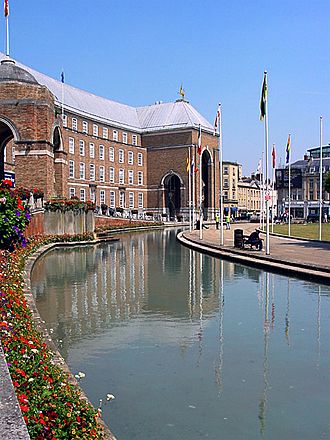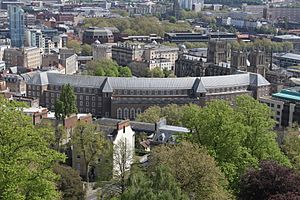City Hall, Bristol facts for kids
Quick facts for kids City Hall |
|
|---|---|

Bristol City Hall
|
|
| General information | |
| Classification | |
|
Listed Building – Grade II*
|
|
| Designated: | 19 March 1981 |
| Reference #: | 1282341 |
| Town or city | Bristol |
| Country | England |
| Coordinates | 51°27′09″N 2°36′11″W / 51.45263°N 2.60295°W |
| Construction started | 1938 |
| Completed | 1952 |
| Opened | 1956 |
| Client | Bristol City Council |
| Design and construction | |
| Architect | Vincent Harris |
City Hall (once called the Council House) is the main building for the city government in Bristol, England. It opened in 1956. The building was designed in the 1930s. Its construction was delayed by the Second World War.
City Hall has a classic, elegant look, known as Neo-Georgian style. It curves along College Green. You can find it across from Bristol Cathedral and near Park Street in the Bristol city centre. This important building is also a Grade II* listed building, meaning it is protected for its special history and architecture.
Contents
Building Bristol's City Hall
Bristol City Hall was built to replace the Old Council House, Bristol. The first stone was laid in 1935. The main structure was finished by 1939. However, work stopped because of the Second World War.
The building was fully completed in 1952. Queen Elizabeth II officially opened it on April 17, 1956. The city council even published a special book about the building at that time.
Design and Style
The architect, Vincent Harris, designed City Hall. He used a Neo-Georgian style. This means it looks like older Georgian buildings, but with modern touches. The building has a concrete frame. It is covered with wide, thin bricks. Portland stone was used for decorative parts. It also has a steep, lead-covered roof. Golden unicorn statues sit on top of the end sections of the building.
Inside City Hall
The main entrance faces a moat (a water-filled ditch). It leads into the reception hall. This hall is decorated with local Doulting stone. The floor is made of black and white Italian marble. You can also see a blue and gold wall clock. It has the signs of the zodiac around it. This clock even shows the wind direction!
The Conference Hall is the biggest room inside. The names of all Mayors and Lord Mayors of Bristol since 1216 are carved into its stone walls. The Lord Mayor's Reception Room has walls covered in English walnut wood. It also features a colorful design. This design shows the symbols of Bristol's trade guilds. It also lists famous Bristolians in gold letters.
Name Change
The building was first known as the Council House. But its name changed to City Hall. This happened on November 19, 2012. George Ferguson, the Mayor of Bristol, made the change on his first day in office.
Special Features of City Hall
Art in the Council Chamber
The ceiling of the council chamber is very special. It was designed by John Armstrong. He was an artist who lived from 1893 to 1973. His design shows buildings in Bristol around the edges. In the center, it features sailing ships from different times in Bristol's history. The four corners of the ceiling show figures representing Enterprise, Wisdom, Industry, and Navigation.
Conference Room Ceiling
The ceiling in the Conference Room also has unique art. It was created by Sir Walter Thomas Monnington. He was an artist from 1902 to 1976. His artwork on the ceiling is about molecular and atomic fusion.
Tony Benn Bust
In 2005, a statue was placed in the building's foyer. It is a bust (a sculpture of the head and shoulders) of Tony Benn. He was a famous politician. Tony Benn was a Member of Parliament for Bristol for many years. He even unveiled the bust himself.
Eco-Friendly Updates
City Hall has been updated to be more environmentally friendly. Its electrical and heating systems were refurbished. Now, rainwater is collected and used to flush toilets. The air-conditioning system is also smart. It releases extra heat into the surrounding moat. This stops the heat from going into the air.
City Hall in Popular Culture
- One of the golden unicorns on the building appears in the opening of the TV show, Skins. You can see it in the first and fifth seasons.
- Another unicorn is featured on the latest £B10 banknote of the Bristol Pound. It appears as a hologram.


